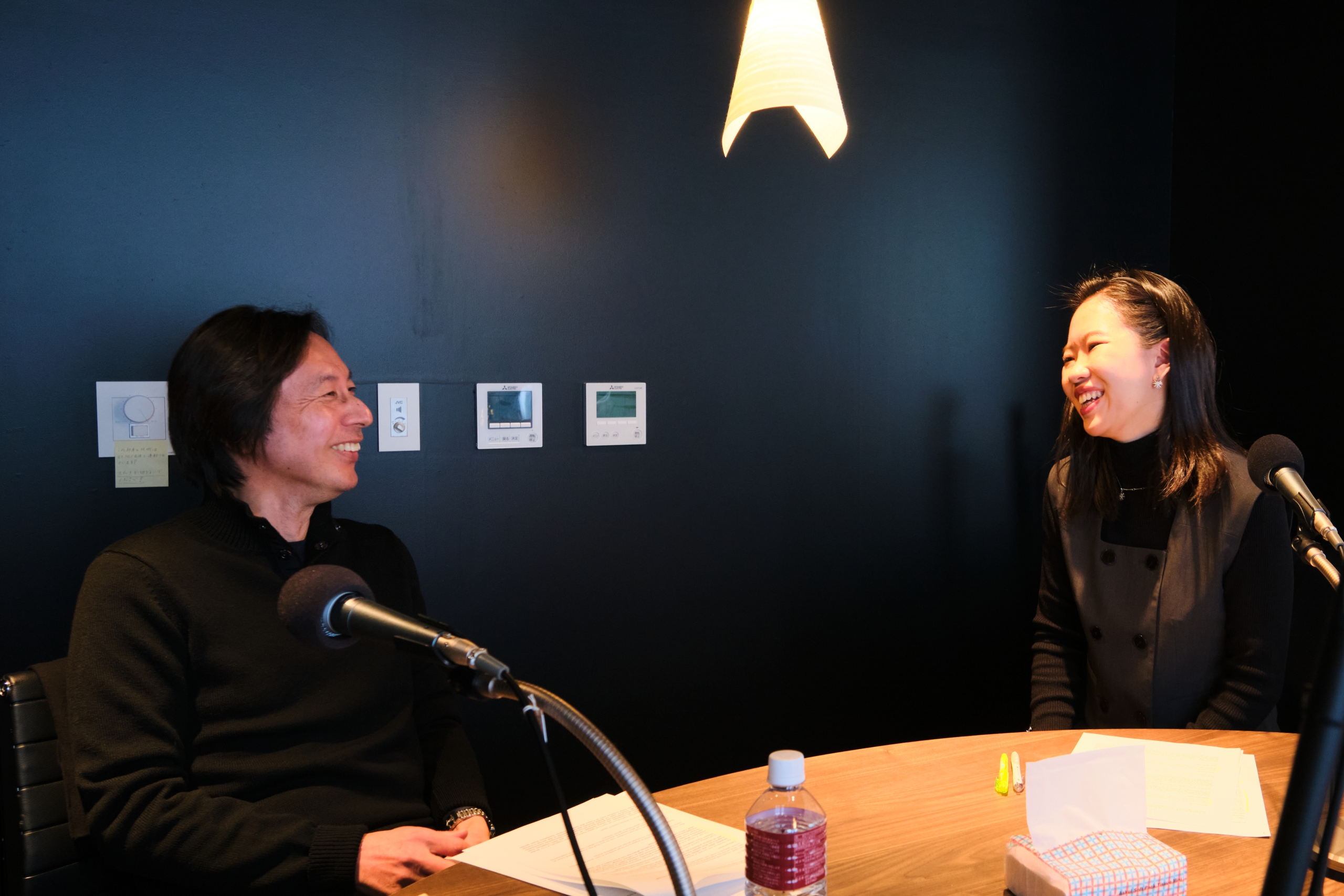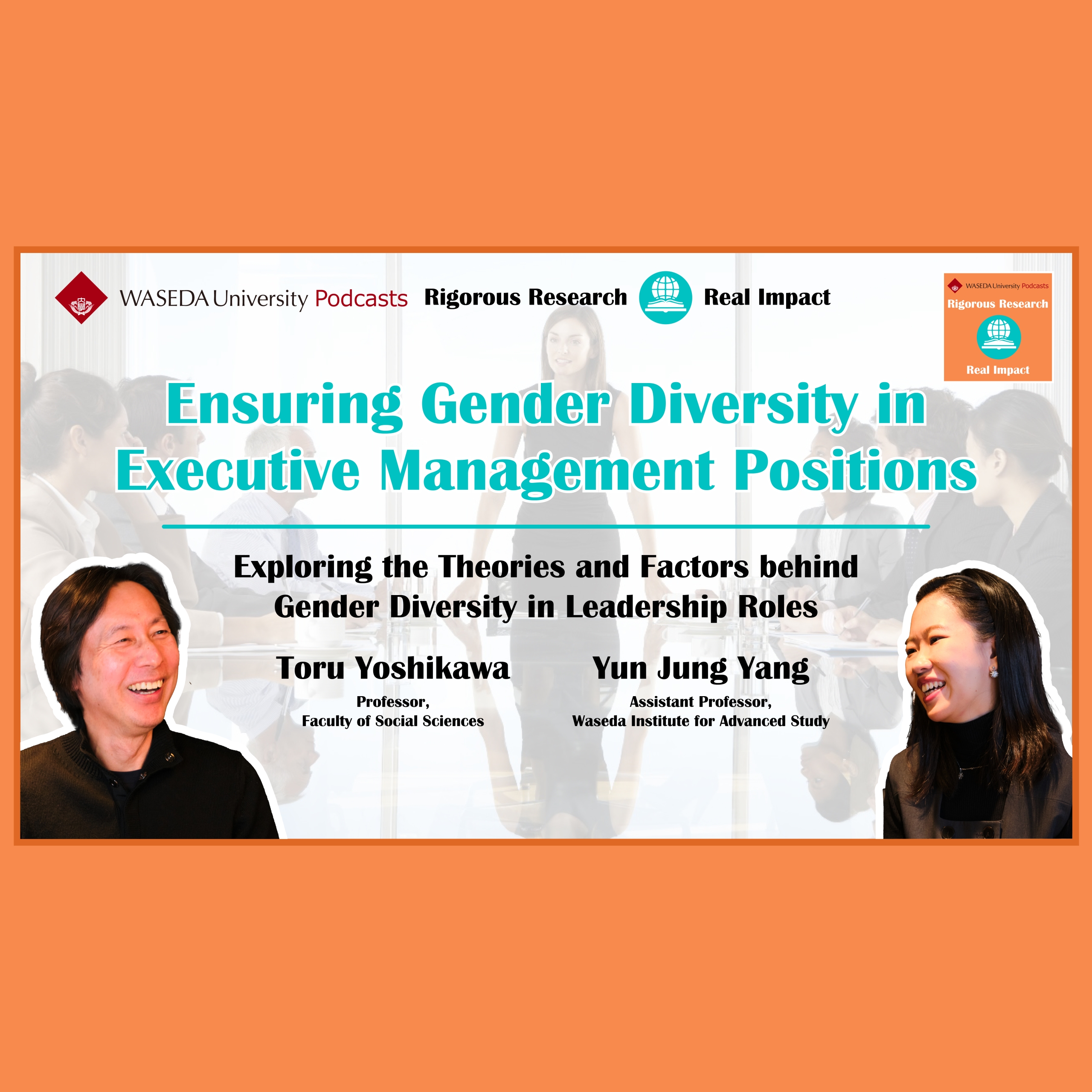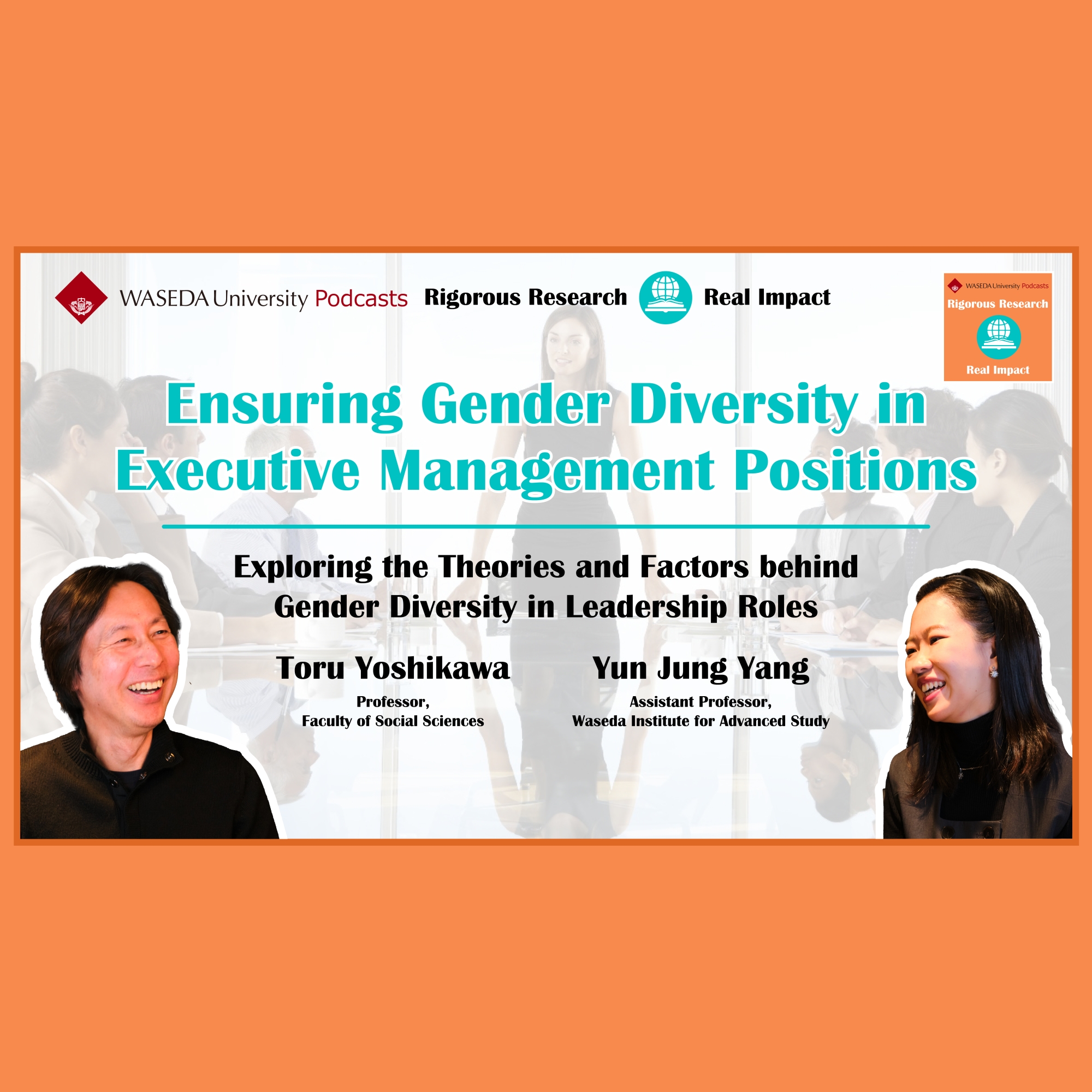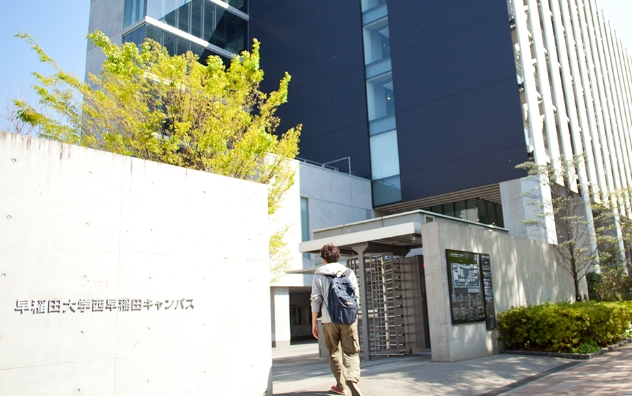【Waseda University Podcasts: Rigorous Research, Real Impact】“Ensuring Gender Diversity in Executive Management Positions”
Tue, Feb 4, 2025-
Tags
Waseda University released the seventh episode, “Ensuring Gender Diversity in Executive Management Positions”, of its English language podcast series “Rigorous Research, Real Impact” on February 4, 2025. All podcast episodes are available for free on Spotify, Apple Podcasts, Amazon Music, and YouTube.

Professor Yoshikawa and Assistant Professor Yang recording at the Haruki Murakami Library
Episode 7: “Ensuring Gender Diversity in Executive Management Positions”

In episode 7, Professor Toru Yoshikawa (Faculty of Social Sciences) speaks with MC Assistant Professor Yun Jung Yang (Waseda Institute for Advanced Study) about his recent research exploring gender diversity in top management teams, particularly women in the role of the Chief Human Relations Officer (CHRO). Professor Yoshikawa worked with a team of researchers that investigated why women are increasingly appointed to the CHRO position in the US but less so to other executive roles. Additionally, he uses his expertise to reflect on gender diversity, ESG (environmental/social/governance), and DEI (diversity/equity/inclusion) initiatives at companies in Japan, as well.
“Waseda University Podcasts: Rigorous Research, Real Impact”

○ Apple Podcasts
○ Spotify
○ Amazon Music
○ YouTube
About the Series:
Waseda University’s first ever English-language academic podcast titled “Waseda University Podcasts: Rigorous Research, Real Impact” is an 8-episode series broadly showcasing the diverse work of our renowned social sciences and humanities researchers. In each of the short 15-30 minute episodes we welcome a knowledgeable researcher to casually converse with an MC about their recent, rigorously conducted research, the positive impact it has on society, and their thoughts on working in Japan at Waseda. It’s a perfect choice for listeners with a strong desire to learn, including current university students considering graduate school, researchers looking for their next collaborative project, or even those considering working for a university that stresses the importance of interdisciplinary approaches.
About the Guests:
Professor Toru Yoshikawa (Guest)
Dr. Toru Yoshikawa began working at Waseda University’s Faculty of Social Sciences in 2023. He specializes in business administration, strategic management, corporate governance, top management teams, innovation, and international business. He obtained his PhD from York University and has previously taught at Nihon University, McMaster University, and Singapore Management University. Prior to that he spent a number of years working in the finance industry. Dr. Yoshikawa is a member of the Academy of Management, the Academy of International Business, the Strategic Management Society, and the International Corporate Governance Society.
Assistant Professor Yun Jung Yang (MC)
Dr. Yun Jung Yang is an Assistant Professor at the Waseda Institute for Advanced Study (WIAS). Her primary research interests lie at the intersection of international politics (international relations) and comparative politics, and more specifically armed conflict and human rights violations. In particular, she mainly investigates child soldiering and rebel groups’ tactical decisions during armed conflict. Dr. Yang is also interested in overall human rights violations in conflict zones, conflict outbreak and management, international regulations (i.e. international laws), international security, and criminal psychology. She received her PhD from the Department of Government, University of Essex in 2022.
Transcript:
Assistant Professor Yun Jung Yang (MC) (00:00:05:09)
Hello and welcome to Waseda University’s English podcast series titled “Rigorous Research, Real Impact.” In this series, we dive into interesting conversations and stories from Waseda’s vibrant academic and cultural community.
I am Yun Jung Yang, an Assistant Professor at the Waseda Institute for Advanced Study. Today, we are thrilled to have Professor Toru Yoshikawa from Waseda’s Faculty of Social Sciences with us. Dr. Yoshikawa’s research focuses on corporate governance, strategic management, leadership diversity, and organizational culture. He deals with topics related to strategic leadership and the impact of gender in executive succession and has published his research in leading journals such as Leadership Quarterly, Journal of Business Research, and Asia Pacific Journal of Management.
In today’s conversation, we will be discussing his recently published article titled “Female CHRO Appointments: A Crack in the Glass Ceiling?” In his article, Dr. Yoshikawa examines the increase in appointments of female successors to the executive role of Chief Human Resources Officer in an effort to understand how we can increase gender diversity at the top management level.
Asst. Prof. Yang (MC) (00:01:39:06)
Before we get into details, could you tell us about your background and what motivated you to focus on leadership diversity and organizational culture in your research?
Professor Toru Yoshikawa (Guest) (00:01:51:12)
Thank you for your question. Just to give you my background briefly. Before my academic career as a professor, I was in the finance industry for almost eight years, year and a half in Tokyo, and about six and a half years in Toronto, Canada. So, during my career as a finance professional, I witnessed the bubble economy in Japan in 1980s and the burst of the bubble economy in 1990s.
So, I look at the rise and the decline of Japan’s economy. Also, Japanese companies from 1980s–1990s. So, I got curious about the role of key decision-makers such as top executives and board members because they are responsible for making key decisions for the companies. So, I quit my finance job and got into to the Ph.D. program in Canada so that I can pursue a research career looking at the world top executives and the board members, especially the implications of their strategy and performance.
Asst. Prof. Yang (MC) (00:02:54:13)
Thank you, Dr. Yoshikawa. We’d love to hear more about your main field of work and most importantly, what do you hope to achieve through your research?
Prof. Toru Yoshikawa (Guest) (00:03:05:07)
In my research, that’s a very big question. My major topics are corporate governance and the TMTs, top management teams, and the strategic management, innovation, and also social impact of corporations right now, like ESG or DEI at the moment.
And I’m hoping—well, actually, earlier days I was looking at the impact of external environments such as capital markets or shareholders on companies’ key decisions and gradually I shifted my attention to the internal decision-making mechanisms of corporations, namely TMTs and the board of directors.
So, my goal at this moment is to explore the role of those key decision-makers, not only financial but also the social implications, including diversity in the corporations in Japan, also outside Japan.
Asst. Prof. Yang (MC) (00:04:06:09)
Your most recent research focuses on gender diversity at the top management level, specifically looking at female appointments to the role of Chief Human Resources Officer or CHRO in the US.
What motivated you to study this topic? And can you give us a general picture of what gender diversity currently looks like in top management teams?
Prof. Toru Yoshikawa (Guest) (00:04:32:21)
Okay, actually my interest was Japanese companies, not US companies at the beginning. But so, we are exploring some topics that we can examine in Japanese companies in terms of diversity in the TMTs or board of directors.
Then I have a colleague in the US at John Hopkins University. He was my former Ph.D. student in Singapore and he is the HR expert. And, he’s looking at the Chief HR Officer in the US companies for some time. And he found out that in the last 15 years, the female ratio of Chief HR Officer has been increasing tremendously from like a 40% to over 60%.
So, we got curious: why this is happening in the US? Why are most CHR officers in US companies mostly women? So, that’s the motivation for us to explore this topic.
Asst. Prof. Yang (MC) (00:05:26:09)
As mentioned, your study explores the dynamics of executive succession, particularly in the non-chief executive officer role of the CHRO. Why focus on the CHRO role specifically and not for example, the CEO or CFO role?
Prof. Toru Yoshikawa (Guest) (00:05:48:08)
Okay, that’s also a very good question. If you look at the research in the TMT domain, there are so many studies that look at CEOs, including female CEOs. There are also few studies on CFOs, but not many studies on the CHR officer yet.
And also as I mentioned earlier, my colleague in US is an HR expert. So, he is asking us to join his project and explore the role of human resource officers at the top echelons of the corporation. What function do they play? How do they impact the diversity within the corporation?
Okay, so shifting away from CEO was our primary motivation. We look at other executives who are also key decision-makers in the corporation.
Asst. Prof. Yang (MC) (00:06:34:16): Sounds interesting.
Prof. Toru Yoshikawa (Guest) (00:06:36:07): Thank you.
Asst. Prof. Yang (MC) (00:06:37:06)
Dr. Yoshikawa, your study brings in social role and social categorization theories to explain gender shift in the CHRO role. Can you explain a bit more about these theories for our audience and how they help us understand gender diversity in firm leadership?
Prof. Toru Yoshikawa (Guest) (00:06:57:17)
Okay, so these two theories came from social psychology. So according to the social role theory, okay. All of us, with no exception, tend to have gendered role perceptions in terms of occupations. For example firefighters, policemen, or nurses. We tend to have some, you know, the gendered perception that the firefighter should be men, nurses should be women, or kindergarten teachers should be women, right? So, that’s the perception we always carry. Which means we all have unconscious bias in terms of occupations that we observe in day-to-day life.
So the social world theory assumes that such a bias impacts our perception of the position holders. For example, if a female hold top corporate decisions, we don’t see female as the suitable position occupant. So, we have bias against those people who are holding men’s position. That’s assertion made by the social role theory.
Okay. As for the social categorization theory, again, we tend to differentiate in-group members and out-group members by some dimensions in social categories such as gender, education, nationality, ethnicity, and so on and so forth.
Okay. So, we think we see other people as inside members, in-group members. We tend to have favorable perceptions of those individuals. We treat them well. However, for out-group members, we don’t treat them very well because they are not one of us. Women tend to be categorized as outside members for the male-dominated executive suite. So, that’s also become basis of the gender bias.
Asst. Prof. Yang (MC) (00:08:53:10)
Thank you so much for sharing such a detailed explanation. In your research you identify key factors driving the gender shift in CHRO roles. Could you walk us through these factors and explain their significance in understanding the growing presence of women in senior HR positions?
Prof. Toru Yoshikawa (Guest) (00:09:15:16)
Okay. In the CHR position in the US companies, gender shift from male to female doesn’t happen, not as much as we predicted. So, when you have a male CHR officer, right. His successor tend to be also men, as well. And however, once female occupy the position, then women succeed the position.
Okay, so gender shift is not always automatic. So, we found that there are some external forces kind of become a trigger to facilitate a gender shift in this particular position.
Asst. Prof. Yang (MC) (00:09:52:18)
Your recent study also suggests that exposure to external information can influence the social categorization effect in leadership roles. Can you say a bit more about this and elaborate on what specific exposure you mean?
Prof. Toru Yoshikawa (Guest) (00:10:08:16)
Okay, so to have more women in the top executive positions, there are two ways. One is the creation of new positions, right? To appoint women to the position or gender shift, replace men with women.
Okay. So in our research we look at the latter. Replacement of men with women. Okay. So, to have that to happen, we noticed that it’s not always automatic. We need some external forces for the shift to take place.
So, we notice that if you have CEOs who are linked with other corporations that have female CHR officers, then he brings back the practice to the home institution, then gender shift happens. That’s one way.
Number two, if your company is an industry where many other companies already have female chief HR officers, then they feel pressure to appoint females. Then shift happens. The two mechanisms, the external forces, you know, that motivate companies to make a shift.
Asst. Prof. Yang (MC) (00:11:17:12)
How do you think external exposure, such as global trends and cross-cultural interactions, can reshape perceptions of gender in top management?
Prof. Toru Yoshikawa (Guest) (00:11:28:06)
Okay, so actually my earlier studies look at the impact of shareholders, especially global, the professional investors, okay.
And we noticed that the global investors tend to prefer greater diversity at the top echelon of the corporation. When the company has greater exposure to foreign investors who care about diversity, the company tends to have more females in the board and TMTs.
So, that’s one external pressure company feels right now to adapt to new norms of diversity.
Asst. Prof. Yang (MC) (00:12:08:01)
And this brings me to my next question. You mentioned that the initial gender shift in leadership positions is a critical turning point for organizations. Could you explain why this is so significant and what impact it has on the future trajectory of gender diversity in top roles?
Prof. Toru Yoshikawa (Guest) (00:12:30:21)
Okay. As I mentioned earlier, the corporate leaders are often categorized as men’s position. Okay. So the female holding those positions are not institutionalized, not accepted within the corporation yet.
But once we have a woman in those positions, right? Then people tend to see, “Oh, she can be in the position.”
So, they change the mindset, okay. Which triggers greater institutionalization of females holding some executive positions. That’s the importance of having a female, any first female in any top positions, which changes the mindset of many other people.
Asst. Prof. Yang (MC) (00:13:10:20)
One of the key points in your study is that gender diversity at the top management level can benefit firms in various ways. What are some of the specific benefits that organizations gain from increasing female representation in leadership roles?
Prof. Toru Yoshikawa (Guest) (00:13:28:22)
Again, there’s many studies on the topic in the past. A few studies found that greater diversity tends to leads to more innovation for the companies. That’s one key finding.
And another finding is that if you have more females at the top of the organization, the companies tend to engage more with social issues. So, they tend to have high, for example ESG ratings or social ratings by the rating agencies, which also attracts more investors to invest. So, that’s another benefit of having great diversity at the top of the organization.
Asst. Prof. Yang (MC) (00:14:11:05)
In your paper, you also look at the factors that drive the success of female appointments to CHRO roles. What are the key organizational practices that can ensure these appointments go beyond symbolic gestures to create real sustainable change?
Prof. Toru Yoshikawa (Guest) (00:14:33:05)
Okay, well there’s again many studies done by human resource researchers on that topic. And, I guess one of the key findings is that a mentorship program to nurture female, potential female leaders, helps facilitate the women to get promoted in the future. That’s one thing.
The other main thing may be training, not only female but male employees to change the mindset to accept female leaders. I think that the potential impact of the greater diversity in corporate leadership is that it may attract a more female or other minority job applicants. Because this shows that the company is more open to embracing females and minority employees.
So, the companies become attractive to good talent from the labor market. And also, they are… At the same time, companies have to be also very careful about appointing women to that role. Because, let’s say company only appoint female, so for example female gendered positions, it may send a signal to the labor market that the company has a bias against women. So it’s a double edged sword.
And to achieve the substantive rather than the symbolic leadership diversity, I think the culture change is critical and very essential. Simply appointing a couple of female outside board members on corporate board or appointing a female Chief HR Officer is not usually sufficient to make you know a substantial change in the diversity because such appointments alone may only lead to the rather symbolic gesture to the external stakeholders.
So therefore, in Japan, for example, the TMT’s boards are still male-dominated. So the commitment made by, for example, CEOs/the President is quite essential to make change in corporate culture.
Asst. Prof. Yang (MC) (00:16:35:20)
As the world becomes more interconnected, how do you think the increasing global focus on diversity and inclusion will affect leadership appointments in Japan? What should organizations in Japan learn from global trends in gender diversity?
Prof. Toru Yoshikawa (Guest) (00:16:53:06)
That’s also a very critical question at the moment. I feel look around the world, we don’t see any one clear direction right at the moment. For example, in the US there was strong push for DEI–diversity equity inclusion initiatives.
But in the past few years, the backlash against such initiatives coming from the conservative politicians or interest groups. So, many companies in the US such as Walmart and others, are backtracking DEI at the moment. They’re going backward.
Okay, so many people think we don’t need these kind of initiatives. Why should I, you know, favor minority groups? However, in Europe, it’s very strong. They’re pushing DEI very strongly. Some countries, such as France, Spain, Germany, they have both gender quotas. In those countries you have to have 45% women on board.
But there are different directions right now and Japan is way behind those countries. So I think Japan should look at the US…maybe Europe as a benchmark region to maybe you know follow and maybe, you know, imitate.
Asst. Prof. Yang (MC) (00:18:10:17)
Thank you. Dr. Yoshikawa, I have a couple more questions for you. You’ve moved from Singapore and joined Waseda’s School of Social Sciences last year. So, I would like to ask simply, why Waseda?
Prof. Toru Yoshikawa (Guest) (00:18:26:21)
Okay, so I teach both undergrad and graduate classes. I teach in Japanese and English, okay, to my undergrad students. For graduate students, I only teach in English. So I’ve been teaching in English in the last 21 years outside Japan. So, I feel quite comfortable teaching in English.
Last year, actually two years ago, I was thinking about going back to Japan. So I was talking to some of my colleagues and friends in Japan and some of them recommended Waseda may be a good institution that I should move to because they are very research-oriented and they are trying to become a more global research university. So, that’s the reason I chose Waseda.
Asst. Prof. Yang (MC) (00:19:10:09)
Before we end, what message would you like to leave for the next generation of leaders and researchers who are interested in contributing to gender equality in leadership roles?
Prof. Toru Yoshikawa (Guest) (00:19:23:18)
Okay, so as we all know, Japan is facing a shrinking population and declining workforce, which means Japan’s domestic market will be smaller in the future. There’s nothing that can stop that. Okay, so many companies in Japan need to look at the overseas market, okay, for future growth or simply also for survival itself. Which means many Japanese young leaders, potential leaders in the future, have to look at overseas as the main kind of battleground for the companies.
For leaders, if you look at the Japan, Japan is pushing greater diversity at the moment, but we have to realize Japan is still behind many other countries. So, for young people, they should look beyond norms within Japan and see what’s happening in other countries in embracing greater diversity, not only female, but other minority groups, such as foreigners.
And for researchers, again, I realized that Waseda is in transition to become a global university. I think many of us, especially young researchers, should aim for, kind of, transmitting their research outside Japan, not only in Japanese but also English, so they have more impact in the global research community.
Asst. Prof. Yang (MC) (00:20:58:15)
Dr. Yoshikawa, thank you again for being here and sharing your valuable insights with us. Your research sheds light on the evolving landscape of gender in corporate leadership and highlights the importance of continued efforts towards inclusivity and diversity.
And to our listeners, thank you for tuning in. We hope this episode has deepened your understanding of gender diversity in leadership.
For more such stories and insights from the corridors of Waseda University, don’t forget to subscribe and tune into the next episode on “Rigorous Research, Real Impact.” Until then, take care and stay curious.














